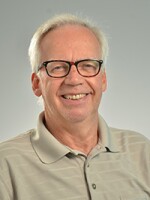The U.S. Open Golf Championship is underway this week in Wisconsin. A Lenexa man has a special connection to this golf major. But he’s not playing on the course.
He helped design it, and Ron Whitten took an unusual route to becoming a golf course architect.
Unlike other young golfers in the 1960s who dreamed to be the next Jack Nicklaus or Arnold Palmer, Ron Whitten says he was fascinated with the golf course’s layout. “I wanted to be a golf course architect,” Whitten says. “When I went to college, I worked on the maintenance at the country club in Lincoln, Nebraska, to learn that end of it.”
Whitten also wrote a lot of golf architects asking for advice.
“This was in 1971, the Nixon recession we called it,” says Whitten. “They all told me I’d starve, so I decided I’d go to law school and study architecture as a hobby and write a book on it because I was a journalism major at Nebraska.”
After law school, Whitten worked as a prosecuting attorney in Shawnee County in the early 1980s, and was best known for a case that headlined the evening television news in Topeka. Whitten was the lead investigator in the 1981 murder of 75-year old Sarah Woody.
“I was called that night in the middle of the night because I was the district attorney on duty for that week, so I went out to the scene and saw the victim when she was found in her car in a parking lot and shot to death,” recalls Whitten.
Woody had been robbed and shot five times. Investigators never found the gun, but several years later forensics matched bullets from a gun used in a Kansas City, Kansas shooting to the Woody murder. After Whitten left the county prosecutor’s office, Ormond Wimberly was convicted of first-degree murder.
“Through a strange sort of situation, I was called as a witness by the defense team rather than the prosecution,” says Whitten.
Ron Wurtz, now a retired public defender, tried to poke holes and find faults in Whitten’s initial investigation. Wurtz says he and Whitten might have butted heads in the courtroom, but there was a mutual respect.
“He would probably one of the people I would say that I wish he’d stay a prosecutor,” says Wurtz. “He was a good guy to work with, and I think was a good lawyer.”
There was something else Wurtz noticed when he would venture over to Whitten’s courthouse office to talk about that or any other case. “Golf magazines, I think, were liable to be more prominent than even the law books in his office,” Wurtz says.
In 1981, the same year as Woody’s murder, Whitten published a book called The Golf Course on the history of golf course architecture. From there, he wrote articles for Golf Digest magazine, which led to a full-time opportunity with the magazine in 1990. Whitten had the best of both worlds: He could write about golf architecture and, at the same time, dabble in designing. He landed his first golf course project in 2001.
By then Whitten’s career in law was in his rear-view mirror.
“I loved the trials aspects of law. But to be honest the law is very confining. It’s black-letter law. There’s a right and wrong. You can’t be creative in the law,” says Whitten. “Golf architecture has no boundary, has no rules.”
To be successful in the business, Whitten has discovered it isn’t all about having name value.
For example, Kansas City’s most well-known golfer, Tom Watson, has his thumbprint on some courses around the area like Shadow Glen in Olathe and The National in Parkville. But as successful as Watson was on the course, Whitten believes Watson has fallen short nationally with his design work.
“He’s one of the top five professional golfers of all time in terms of majors won. Yet his design business has not struck a chord across the nation,” says Whitten.
“He’s done some very fine work, but it’s been one course every two or three years. That always surprised me.”

When Whitten got involved with the design of Erin Hills outside Milwaukee, Wisconsin, he and his two other co-designers, Dr. Michael Hurdzan and Dana Fry, beat out firms that included the big names like Nicklaus and Palmer. The Erin Hills course opened in 2006 and was later chosen by the U.S. Golf Association to host this year’s U.S. Open.
“It’s the ultimate honor. The USGA traditionally takes their U.S. Open to tried and true courses, clubs that have been around for 100 years,” says Whitten. “We’re the second course (the first being Chambers Bay in University Place, WS) built in the 21st century to host a U.S. Open.”
Erin Hills is one of two courses Whitten has helped design literally from the ground up. The first was The Architects Golf Club, co-designed with Stephen Kay in Phillipsburg, New Jersey. He has also remodeled three other courses, and there’s an ongoing project to revive an abandoned course in Leesburg, Virginia.
But this week Whitten is catching his breath from all that. He’s in Wisconsin enjoying the moment and duly noting the feedback received from the best golfers in the world gathered at the U.S. Open.
Greg Echlin is a freelance sports reporter for KCUR 89.3.




